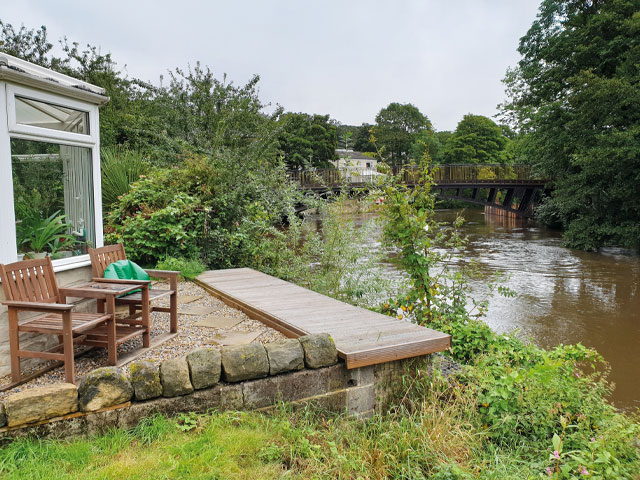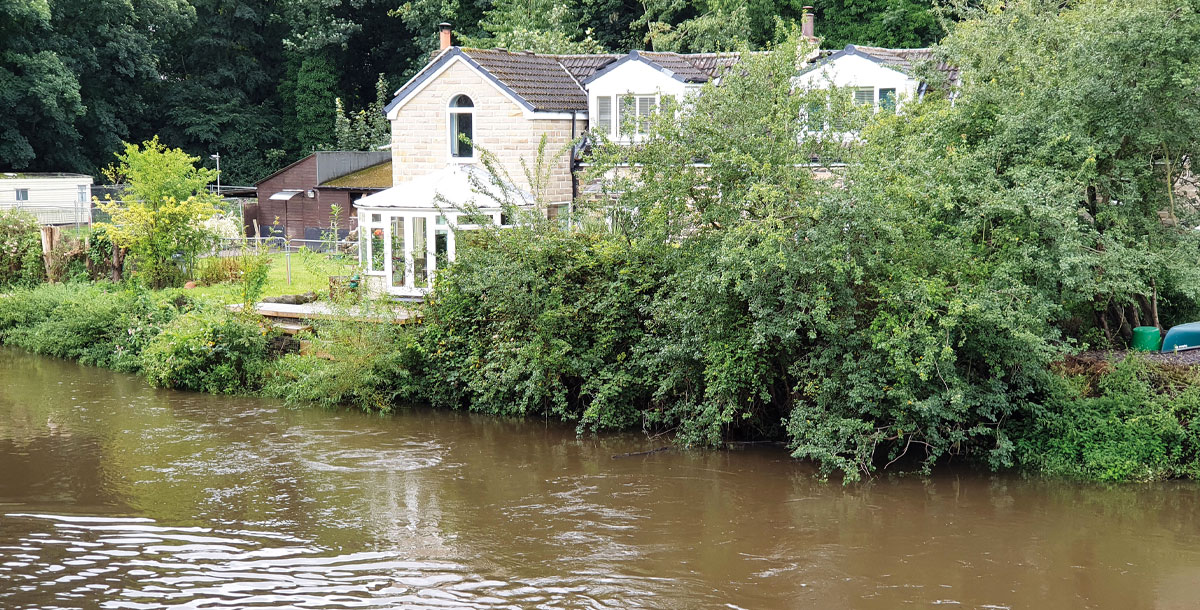Flood-resilient retrofit for a 70s riverside home
How Martin Hughes bolstered his property’s defences while renovating
Situated on the banks of the River Aire in Leeds, Martin Hughes’ picturesque house, built in 1976, hides a variety of unique measure employed to create a flood-resilient house. He was acutely aware of the potential pitfalls of living so close to the river when he moved into the house in 1999. In fact, his garden is a monitoring point for the local council and Environment Agency, the government agency responsible for managing the risk of flooding in England from rivers, reservoirs, estuaries and the sea.
Martin, a surveyor, used the skills he learned working in property restoration – including protecting basements from groundwater – to give his home the best protection against the ongoing threat of flooding from the river. After protecting his own property, he began fitting flood equipment for other businesses and homes across the country. He is represented by the Flood Restoration and Remediation Group within the Property Care Association.
Creating a flood-resilient house
While renovating his home, Martin took heed of the regular flood warnings from the Environment Agency and started installing flood-resilient measures. He initially started by installing air bricks into the walls, which allow air to ventilate the property but shut off during flood conditions. He then bought 400mm-high UPVC flood barriers with foam sealers that could be easily fit over exterior doors to keep flood water out.
Unfortunately, on Boxing Day 2015, following three significant storms – Desmond, Eva and Frank – the water came up higher than the barriers and Martin and his partner were forced to evacuate the property. On returning, and after a lengthy clean-up and drying out process, they set to working on creating a more flood-resilient house. Retrofitting measures included:
- removing wet cavity wall insulation and replacing it with waterproof foam insulation
- repointing all external walls with waterproof mortar up to a height of 1m
- installing internal edge channels that included rodding and wash-out points leading to low level sumps (a place where the water could flow and then be pumped out of the property)
- installing a cavity drainage system, allowing water to move beneath the floor and flow to the sump
- plastic flooring and skirting boards throughout (these come in a range of colours and don’t have to be unattractive)
- some carpets replaced with linoleum, which can easily be washed, dried and reused
- adding additional flood defence measures, such as a ground floor toilet bung to act as a second defence for the non-return valve
- replacing the original 400mm exterior door barriers with larger ones

Martin Hughes’ flood-resilient house sits on the banks of the River Aire in Leeds
‘With flooding becoming more of a reality, we need to make sure our homes have the best protection possible,’ says Martin. ‘The consequences of flooding are horrendous, so doing something to reduce the impact provides us with comfort.
‘If you are moving in to an area of high flood risk, have a specialist carry out a full survey, create a plan with costs, and then fit the measures you choose to install. Speak to two or three companies who can survey the area and install the equipment before going ahead with any works. Flood defences are only as good as the person who designs them and who installs them, so it really is a crucial step.’
What to do in the event of a flood
One of Martin’s top tips is to start the drying out process immediately after a flood to minimise the damage caused. Although insurance companies offer services to dry out properties, they may not be able to get to your property immediately. Speak with the insurer, explain what has happened and get permission to begin the drying process.
Martin used a dehumidifier and blowers after stripping out things like wooden shelving and allowing them to dry flat. He carefully labelled items so he knew what goes where once dry. Don’t throw anything away as it can be used as evidence for insurance purposes and take photos of all the damage.
READ MORE
- How to build a flood-proof house
- The amphibious house in Buckinghamshire
- Flood-proof cantilevered house in Essex
Note: Leeds City Council is working in partnership with the Environment Agency to create a flood storage area by the River Aire. This is part of the Leeds Flood Alleviate Scheme Phase 2 and will create habitats for local wildlife . It is anticipated to be completed by mid-2023.









